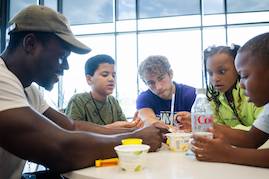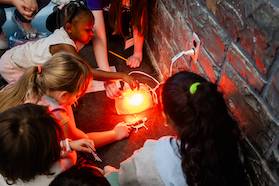About our Partnership
Our partnership with the Boys & Girls Club of Harrisonburg and Rockingham County (BGCHR) started in February 2021. JMU students who are members of JMU STEM Corps visit two Harrisonburg City clubs on Friday afternoons to teach BGCHR members. As the "learning facilitators" (LFs), they work in small groups of 2-3 LFs : 4-6 children. Our 10-week curriculum aims to demonstrate real-world applications of STEM practices while reinforcing science and math ideas learned in school. We consult with Harrisonburg City School K-5 teachers to ensure consistency with what and how students are learning in school and work closely with the BGCHR director and staff to align partnership goals and objectives.


Curriculum
We use a curriculum developed by STEM Center director, Kerry Cresawn, that aims to model real-world integration of STEM disciplines & practices, incorporates standards-aligned foundations, and fosters ways of thinking in STEM. See examples of features described below in this photo gallery.
Key features of our curriculum
I. The why and how of technology in STEM: Several lessons focus on why and how scientists and engineers use technology.
- Using sensing and measuring technologies for these lessons enables us to build on ideas and create simple models with inexpensive materials.
- Students compare usability and reliability of simple (DIY) technology tools to “real-world” tools.
- Students learn how a technology works by (1) building a simple model and (2) comparing the parts (what they look like, how they work together) to those of the more advanced version.
- We encourage students to consider purpose and access when thinking about which technology is best in different situations.
- We use types of energy, a school science-aligned concept, as context for technology applications: thermometers & thermal energy; anemometers & wind energy; and lux meters & light energy.
- Lessons that incorporate mapping skills to highlight how information we find on maps helps us to understand and address problems through STEM.
- Challenges focused on designing a more accessible space.
- Rube Goldberg-inspired design challenges.
III. Science versus Engineering: We strive to use consistent ways of demonstrating the differences between science and engineering by comparing how engineers use science and math ideas to inform design and/or test prototypes, and how scientists use things designed by engineers in their work.
- In science-focused lessons students carry out an investigation to answer scientific questions or build a functional model for understanding a process or phenomenon.
- We have two different types of engineering design lessons, both incorporate the iterative design process and challenge students to build a functional prototype with realistic constraints.
Some lessons challenge students to create a scale model prototype with a “real-world” function that improves human lives (e.g., water filters or safer wheelchair ramps) and others offer students the chance to think further or “outside the box” and focus on mechanism by creating a product with a simple function (e.g., move the ball from x to y position).
IV. Current & Authentic: One reason that STEM education is so varied and challenging is because no one is an expert in "STEM". It is not a single field in which one can earn a degree, it is an approach to understanding and addressing challenges that requires collaboration of individuals with expertise in a long list of fields. In addition to the K-5 teachers reviewing our curriculum, we also consult with experts in the focus discipline for the problem being addressed.
